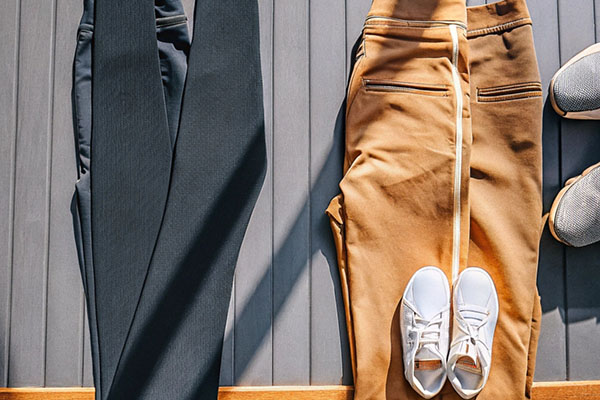Leggings and pants are two staples in modern wardrobes, yet they serve different purposes and are often misunderstood. While both cover the legs and come in various styles, their construction, function, and cultural perception set them apart.
The primary difference between leggings and pants lies in their fabric, fit, and intended use. Leggings1 are stretchy, body-hugging garments designed for comfort and flexibility, while pants2 are structured and tailored for formal or casual wear.
In this article, we’ll explore how leggings differ from pants, answer the question of whether leggings are technically pants, and offer tips on when to choose each.

Are Leggings Technically Pants?
Leggings can be considered a type of pants, but they fall into a specific category with unique characteristics.
1. Why Some Say Yes
- Functional Similarity: Like pants, leggings cover the legs and are worn as a standalone garment.
- Versatility: Leggings are used for activities ranging from workouts to casual outings, similar to certain pants styles3.
2. Why Some Say No
- Fabric and Thickness: Leggings are made from thinner, stretchier materials, while pants are typically more structured.
- Cultural Perception: Pants are associated with more formal or versatile attire, whereas leggings are often seen as athletic or leisurewear.
Conclusion: While leggings technically qualify as pants, their distinct characteristics and cultural context differentiate them.
Key Differences Between Leggings and Pants
To better understand these garments, let’s break down their differences based on fabric, fit, and purpose.
1. Fabric
Leggings:
- Typically made from stretchy materials like spandex, polyester, or cotton blends.
- Designed to be lightweight, flexible, and breathable.
- Some leggings, especially athletic ones, include moisture-wicking properties.
Pants:
- Constructed from a variety of materials, such as denim, wool, or khaki.
- Fabric is usually thicker and more durable, offering more structure.
- Often include details like pockets, zippers, and belt loops.

2. Fit and Style
Leggings:
- Body-Hugging Fit: Designed to fit tightly against the skin, providing a second-skin feel.
- Elastic Waistbands: Often lack buttons or zippers, relying on stretch for fit.
- Styles include ankle-length, cropped, and high-waisted options.
Pants:
- Structured Fit: Typically tailored to provide shape while offering some space around the legs.
- Fastening Details: Include buttons, zippers, and adjustable waistbands.
- Styles range from skinny and straight-leg to wide-leg and bootcut.
3. Purpose
Leggings:
- Best suited for athletic activities, lounging, or casual outings.
- Focuses on comfort and flexibility.
Pants:
- Often chosen for formal, semi-formal, or professional settings.
- Provides a polished appearance suitable for work or events.
4. Functionality
| Feature | Leggings | Pants |
|---|---|---|
| Fabric Thickness | Thin and stretchy | Thicker and more durable |
| Fit | Tight and elastic | Structured and tailored |
| Use Case | Casual, athletic, or loungewear | Formal, casual, or professional wear |
| Details | Minimal design, often pocket-less | Includes zippers, buttons, and functional pockets |
When to Wear Leggings vs. Pants
Knowing when to wear leggings or pants depends on the occasion, activity, and personal preference.

1. Choose Leggings For:
- Workouts: Stretch and flexibility make them ideal for yoga, running, or gym sessions.
- Casual Days: Pair with oversized sweaters or tunics for relaxed outings.
- Travel: Lightweight and comfortable for long journeys.
2. Choose Pants For:
- Work Settings: Opt for trousers, slacks, or chinos for a professional look.
- Formal Events: Tailored pants elevate your outfit for business meetings or celebrations.
- Durable Activities: Jeans or cargo pants provide protection and durability.
The Rise of Leggings in Everyday Fashion
Leggings have transcended their original purpose as athletic wear to become a fashion staple.
1. Athleisure Trend
- Leggings are now styled for casual wear, often paired with sneakers and jackets.
- Brands like Lululemon and Athleta have popularized leggings as stylish and functional.
2. Evolving Designs
- Modern leggings include faux leather styles, patterns, and embellishments, making them suitable for semi-casual occasions.
3. Layering with Leggings
- Pair leggings with long tops, dresses, or skirts for added versatility and modesty.
Are There Pants That Feel Like Leggings?
Some pants offer the structure of traditional trousers with the comfort of leggings.
1. Jeggings
- A hybrid of jeans and leggings, jeggings mimic the look of denim with the stretch of leggings.
2. Ponte Pants
- Made from thick, stretchy fabric, ponte pants provide a polished appearance while maintaining comfort.
3. Stretch Trousers
- Feature elastic waistbands and flexible materials, ideal for office wear or travel.
Pros and Cons of Leggings and Pants
Leggings
Pros:
- Comfortable and flexible
- Lightweight and easy to pack
- Versatile for casual and athletic use
Cons:
- May lack pockets and functionality
- Not suitable for formal settings
Pants
Pros:
- Structured and professional appearance
- Durable and versatile
- Available in numerous styles and fabrics
Cons:
- Less flexibility and stretch
- Can feel restrictive compared to leggings
Conclusion
Leggings and pants serve distinct purposes in modern wardrobes, with leggings excelling in comfort and flexibility while pants provide structure and versatility. Although leggings can technically be considered pants, their unique fit, fabric, and intended use set them apart. By understanding these differences, you can choose the right option for any occasion, whether it’s a workout, casual outing, or professional event.













